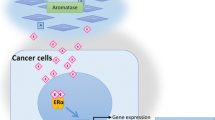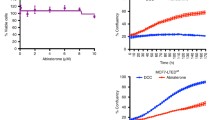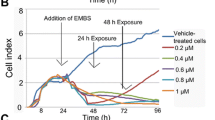Abstract
Different hormonal therapies are used for estrogen receptor positive (ER+) breast cancers, being the third-generation of aromatase inhibitors (AIs), an effective alternative to the classical tamoxifen. AIs inhibit the enzyme aromatase, which is responsible for catalyzing the conversion of androgens to estrogens. In this study, it was evaluated the effects of several steroidal AIs, namely 3β-hydroxyandrost-4-en-17-one (1), androst-4-en-17-one (12), 4α,5α-epoxyandrostan-17-one (13a) and 5α-androst-2-en-17-one (16), on cell proliferation, cell cycle progression and cell death in an ER+ aromatase-overexpressing human breast cancer cell line (MCF-7aro). All AIs induced a decrease in cell proliferation and these anti-proliferative effects were due to a disruption in cell cycle progression and cell death, by apoptosis. AIs 1 and 16 caused cell cycle arrest in G0/G1, while AIs 12 and 13a induced an arrest in G2/M. Moreover, it was observed that these AIs induced apoptosis by different pathways, since AIs 1, 12 and 13a activated the apoptotic mitochondrial pathway, while AI 16 induced apoptosis through activation of caspase-8. These results are important for the elucidation of the cellular effects of steroidal AIs on breast cancer cells and will also highlight the importance of AIs as inducers of apoptosis in hormone-dependent breast cancers.






Similar content being viewed by others
Abbreviations
- MCF-7aro cells:
-
ER-positive aromatase-overexpressing breast cancer cell line
- ER:
-
Estrogen receptor
- SERM:
-
Selective ER modulator
- AIs:
-
Aromatase inhibitors
- DISC:
-
Death-inducing signaling complex
- 1 :
-
3β-hydroxyandrost-4-en-17-one
- 12 :
-
Androst-4-en-17-one
- 13a :
-
4α,5α-epoxyandrostan-17-one
- 16 :
-
5α-androst-2-en-17-one
- MEM:
-
Eagles’s minimum essential medium
- FBS:
-
Fetal bovine serum
- CFBS:
-
Pre-treated charcoal heat-inactivated fetal bovine serum
- T:
-
Testosterone
- PI:
-
Propidium iodide
- PS:
-
Phosphatidylserine
- ∆Ψm:
-
Mitochondrial transmembrane potential
- DiOC6(3):
-
3,3′-dihexyloxacarbocyanine iodide
- 7-AAD:
-
7-aminoactinomycin D
- STS:
-
Staurosporine
- CCCP:
-
Carbonyl cyanide m-chlorophenylhydrazone
- RLU:
-
Relative luminescence units
- ROS:
-
Intracellular reactive oxygen species
- DCFH2-DA:
-
2′,7′-dichlorodihydrofluorescein diacetate
- PMA:
-
Phorbol 12-myristate 13-acetate
- MFI:
-
Mean fluorescence intensity
References
Ferlay J, Parkin DM, Steliarova-Foucher E (2010) Estimates of cancer incidence and mortality in Europe in 2008. Eur J Cancer 46:765–781
Chen S (2011) An “omics” approach to determine the mechanisms of acquired aromatase inhibitor resistance. OMICS 15:347–352
Dutta U, Pant K (2008) Aromatase inhibitors: past, present and future in breast cancer therapy. Med Oncol 25:113–124
Santen RJ, Brodie H, Simpson ER, Siiteri PK, Brodie A (2009) History of aromatase: saga of an important biological mediator and therapeutic target. Endocr Rev 30:343–375
Zilli M, Grassadonia A, Tinari N et al (2009) Molecular mechanisms of endocrine resistance and their implication in the therapy of breast cancer. Biochim Biophys Acta 1795:62–81
Giuliano M, Schifp R, Osborne CK, Trivedi MV (2011) Biological mechanisms and clinical implications of endocrine resistance in breast cancer. Breast 20(Suppl 3):S42–S49
Miller WR, Bartlett J, Brodie AM et al (2008) Aromatase inhibitors: are there differences between steroidal and nonsteroidal aromatase inhibitors and do they matter? Oncologist 13:829–837
Miki Y, Suzuki T, Hatori M et al (2007) Effects of aromatase inhibitors on human osteoblast and osteoblast-like cells: a possible androgenic bone protective effects induced by exemestane. Bone 40:876–887
Lewis-Wambi JS, Jordan VC (2009) Estrogen regulation of apoptosis: how can one hormone stimulate and inhibit? Breast Cancer Res 11:206
Song RX, Santen RJ (2003) Apoptotic action of estrogen. Apoptosis 8:55–60
Kyprianou N, English HF, Davidson NE, Isaacs JT (1991) Programmed cell death during regression of the MCF-7 human breast cancer following estrogen ablation. Cancer Res 51:162–166
Truchet I, Jozan S, Guerrin M, Mazzolini L, Vidal S, Valette A (2000) Interconnections between E2-dependent regulation of cell cycle progression and apoptosis in MCF-7 tumors growing on nude mice. Exp Cell Res 254:241–248
Detre S, Salter J, Barnes DM et al (1999) Time-related effects of estrogen withdrawal on proliferation- and cell death-related events in MCF-7 xenografts. Int J Cancer 81:309–313
Thiantanawat A, Long BJ, Brodie AM (2003) Signaling pathways of apoptosis activated by aromatase inhibitors and antiestrogens. Cancer Res 63:8037–8050
Sasano H, Sato S, Ito K et al (1999) Effects of aromatase inhibitors on the pathobiology of the human breast, endometrial and ovarian carcinoma. Endocr Relat Cancer 6:197–204
Itoh T, Karlsberg K, Kijima I et al (2005) Letrozole-, anastrozole-, and tamoxifen-responsive genes in MCF-7aro cells: a microarray approach. Mol Cancer Res 3:203–218
Cepa MM, Tavares da Silva EJ, Correia-da-Silva G, Roleira FM, Teixeira NA (2005) Structure-activity relationships of new A, D-ring modified steroids as aromatase inhibitors: design, synthesis, and biological activity evaluation. J Med Chem 48:6379–6385
Cepa M, Correia-da-Silva G, Tavares da Silva EJ et al (2008) Molecular mechanisms of aromatase inhibition by new A, D-ring modified steroids. Biol Chem 389:1183–1191
Cepa M, Correia-da-Silva G, da Silva EJ, Roleira FM, Borges M, Teixeira NA (2008) New steroidal aromatase inhibitors: suppression of estrogen-dependent breast cancer cell proliferation and induction of cell death. BMC Cell Biol 9:41
Amaral C, Borges M, Melo S, da Silva ET, Correia-da-Silva G, Teixeira N (2012) Apoptosis and autophagy in breast cancer cells following exemestane treatment. PLoS One 7:e42398
Varela C, Tavares da Silva EJ, Amaral C et al (2012) New structure-activity relationships of A- and D-ring modified steroidal aromatase inhibitors: design, synthesis, and biochemical evaluation. J Med Chem 55:3992–4002
Numazawa M, Mutsumi A, Hoshi K, Koike R (1989) 19-Hydroxy-4-androsten-17-one: potential competitive inhibitor of estrogen biosynthesis. Biochem Biophys Res Commun 160:1009–1014
Numazawa M, Kamiyama T, Tachibana M, Oshibe M (1996) Synthesis and structure-activity relationships of 6-substituted androst-4-ene analogs as aromatase inhibitors. J Med Chem 39:2245–2252
Amaral C, Varela C, Azevedo M et al (2013) Effects of steroidal aromatase inhibitors on sensitive and resistant breast cancer cells: aromatase inhibition and autophagy. J Steroid Biochem Mol Biol 135C:51–59
DiPaola RS (2002) To arrest or not to G(2)-M Cell-cycle arrest : commentary re: a. K. Tyagi et al., Silibinin strongly synergizes human prostate carcinoma DU145 cells to doxorubicin-induced growth inhibition, G(2)-M arrest, and apoptosis. Clin. cancer res., 8: 3512–3519, 2002. Clin Cancer Res 8:3311–3314
Kroemer G (1998) The mitochondrion as an integrator/coordinator of cell death pathways. Cell Death Differ 5:547
Kroemer G, Galluzzi L, Brenner C (2007) Mitochondrial membrane permeabilization in cell death. Physiol Rev 87:99–163
Ghobrial IM, Witzig TE, Adjei AA (2005) Targeting apoptosis pathways in cancer therapy. CA Cancer J Clin 55:178–194
Wajant H (2002) The Fas signaling pathway: more than a paradigm. Science 296:1635–1636
Debatin KM (2004) Apoptosis pathways in cancer and cancer therapy. Cancer Immunol Immunother 53:153–159
Kantari C, Walczak H (2011) Caspase-8 and bid: caught in the act between death receptors and mitochondria. Biochim Biophys Acta 1813:558–563
Cagnol S, Chambard JC (2010) ERK and cell death: mechanisms of ERK-induced cell death–apoptosis, autophagy and senescence. FEBS J 277:2–21
de Vries JF, Wammes LJ, Jedema I et al (2007) Involvement of caspase-8 in chemotherapy-induced apoptosis of patient derived leukemia cell lines independent of the death receptor pathway and downstream from mitochondria. Apoptosis 12:181–193
Petak I, Houghton JA (2001) Shared pathways: death receptors and cytotoxic drugs in cancer therapy. Pathol Oncol Res 7:95–106
Ferreira CG, Span SW, Peters GJ, Kruyt FA, Giaccone G (2000) Chemotherapy triggers apoptosis in a caspase-8-dependent and mitochondria-controlled manner in the non-small cell lung cancer cell line NCI-H460. Cancer Res 60:7133–7141
van Raam BJ, Salvesen GS (2012) Proliferative versus apoptotic functions of caspase-8 Hetero or homo: the caspase-8 dimer controls cell fate. Biochim Biophys Acta 1824:113–122
Zhou DJ, Pompon D, Chen SA (1990) Stable expression of human aromatase complementary DNA in mammalian cells: a useful system for aromatase inhibitor screening. Cancer Res 50:6949–6954
Sun XZ, Zhou D, Chen S (1997) Autocrine and paracrine actions of breast tumor aromatase. A three-dimensional cell culture study involving aromatase transfected MCF-7 and T-47D cells. J Steroid Biochem Mol Biol 63:29–36
Acknowledgments
The authors are grateful to Fundação para a Ciência e Tecnologia (FCT) for the PhD grants attributed to Cristina Amaral (SFRH/BD/48190/2008) and Carla Varela (SFRH/BD/44872/2008). This work was funded by FEDER Funds through the Operational Competitiveness Program- COMPETE and by National Funds through FCT under the project FCOMP-01-0124-FEDER-020970 (PTDC/QUI-BIQ/120319/2010). We thank Dr. Shiuan Chen for kindly supplying MCF-7aro cells.
Conflict of interest
The authors have no conflict of interest to declare.
Author information
Authors and Affiliations
Corresponding author
Rights and permissions
About this article
Cite this article
Amaral, C., Varela, C., Borges, M. et al. Steroidal aromatase inhibitors inhibit growth of hormone-dependent breast cancer cells by inducing cell cycle arrest and apoptosis. Apoptosis 18, 1426–1436 (2013). https://doi.org/10.1007/s10495-013-0879-6
Published:
Issue Date:
DOI: https://doi.org/10.1007/s10495-013-0879-6




